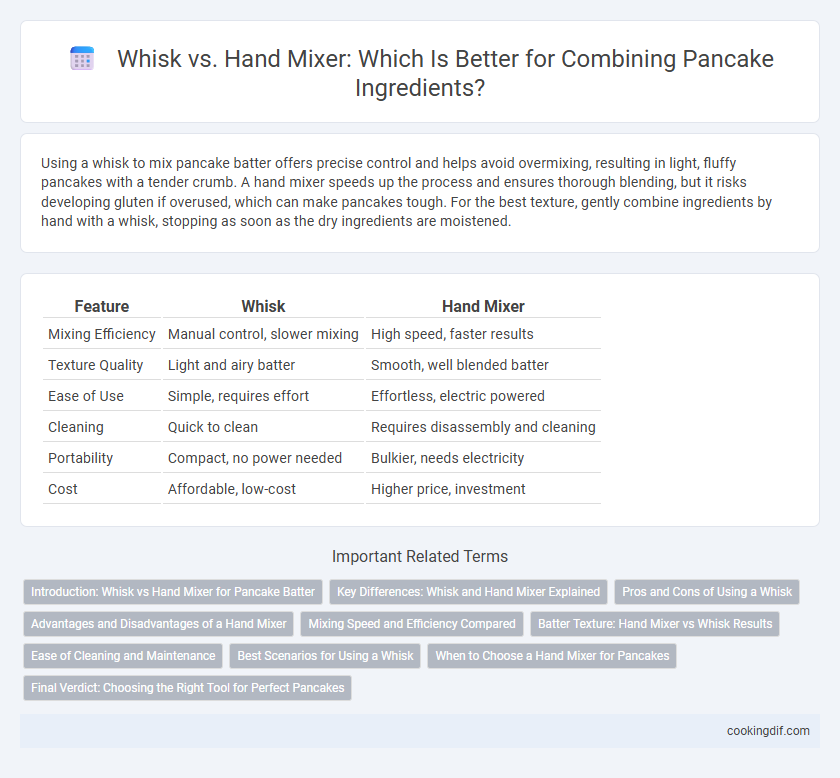Using a whisk to mix pancake batter offers precise control and helps avoid overmixing, resulting in light, fluffy pancakes with a tender crumb. A hand mixer speeds up the process and ensures thorough blending, but it risks developing gluten if overused, which can make pancakes tough. For the best texture, gently combine ingredients by hand with a whisk, stopping as soon as the dry ingredients are moistened.
Table of Comparison
| Feature | Whisk | Hand Mixer |
|---|---|---|
| Mixing Efficiency | Manual control, slower mixing | High speed, faster results |
| Texture Quality | Light and airy batter | Smooth, well blended batter |
| Ease of Use | Simple, requires effort | Effortless, electric powered |
| Cleaning | Quick to clean | Requires disassembly and cleaning |
| Portability | Compact, no power needed | Bulkier, needs electricity |
| Cost | Affordable, low-cost | Higher price, investment |
Introduction: Whisk vs Hand Mixer for Pancake Batter
A whisk offers precise control and helps prevent overmixing pancake batter, preserving its light and fluffy texture. Hand mixers provide faster and more consistent blending, ideal for larger batches or thicker batters. Choosing between a whisk and a hand mixer depends on the desired batter consistency and preparation speed.
Key Differences: Whisk and Hand Mixer Explained
A whisk provides manual control and is ideal for small batches or delicate folding, allowing precise texture adjustments during pancake batter preparation. A hand mixer offers faster mixing and consistent results, efficiently incorporating ingredients and aerating batter for fluffier pancakes. Choosing between them depends on desired speed, texture control, and batch size in pancake making.
Pros and Cons of Using a Whisk
Using a whisk for combining pancake ingredients offers precise control over mixing, which helps prevent overbeating and maintains a light, airy batter texture. It is lightweight, inexpensive, and easy to clean, making it ideal for small batches or simple recipes. However, hand mixing with a whisk can be time-consuming and requires more physical effort compared to a hand mixer, especially when dealing with thicker batters or larger quantities.
Advantages and Disadvantages of a Hand Mixer
A hand mixer offers powerful and consistent mixing, making it ideal for quickly combining pancake batter to a smooth texture without overworking the gluten. Its adjustable speed settings provide precision control, ensuring even incorporation of ingredients, while its electric operation reduces physical effort and saves time compared to manual whisking. However, hand mixers require access to electricity, can be heavier and noisier than a whisk, and may be less effective at gently folding delicate ingredients, which can affect the pancake's fluffiness.
Mixing Speed and Efficiency Compared
A hand mixer offers faster mixing speeds and greater efficiency compared to a whisk, making it ideal for quickly combining pancake batter to a smooth consistency. While a whisk requires manual effort and can be slower, it provides more control over mixing speed for delicate batters. Hand mixers reduce preparation time, especially when dealing with thicker mixtures or larger quantities of pancake ingredients.
Batter Texture: Hand Mixer vs Whisk Results
Using a hand mixer for pancake batter produces a smoother, more aerated texture compared to a whisk, which may leave small lumps due to less consistent mixing. The hand mixer's rapid, uniform motion incorporates air evenly, resulting in lighter, fluffier pancakes with a more uniform crumb. In contrast, a whisk requires more effort to achieve the same level of smoothness, often yielding a denser batter with slight textural inconsistencies.
Ease of Cleaning and Maintenance
A whisk offers simple cleaning and minimal maintenance since it has no electrical parts and can be thoroughly rinsed under running water or easily washed by hand. Hand mixers, while more effective for thorough mixing, require disassembly of beaters and careful cleaning to prevent damage to the motor housing and electrical components. For quick cleanup and low upkeep, a whisk is ideal, whereas a hand mixer demands more time and attention to maintain its performance and longevity.
Best Scenarios for Using a Whisk
A whisk is ideal for gently combining pancake batter when a light, airy texture is desired, as it incorporates air effectively without overmixing. It works best for small batches or when using delicate ingredients like eggs and milk, ensuring a smooth consistency without activating too much gluten. For simple, quick mixing tasks, the whisk provides precise control and minimizes the risk of batter becoming tough or lumpy.
When to Choose a Hand Mixer for Pancakes
A hand mixer is ideal for pancakes when you need consistent batter without overmixing, as its controlled speed helps achieve a smooth, lump-free texture. It efficiently combines wet and dry ingredients, saving time compared to a whisk, especially for larger batches. Choose a hand mixer to maintain the delicate gluten structure, ensuring fluffy, tender pancakes.
Final Verdict: Choosing the Right Tool for Perfect Pancakes
Whisking pancake batter by hand offers greater control over consistency, ensuring a light, fluffy texture by preventing overmixing and gluten development. Hand mixers provide speed and ease, especially for larger batches, but risk incorporating excess air or overbeating, which can lead to dense pancakes. For perfect pancakes, choose a whisk when precision and texture matter most, and opt for a hand mixer when efficiency and volume are the priority.
Whisk vs hand mixer for combining ingredients Infographic

 cookingdif.com
cookingdif.com